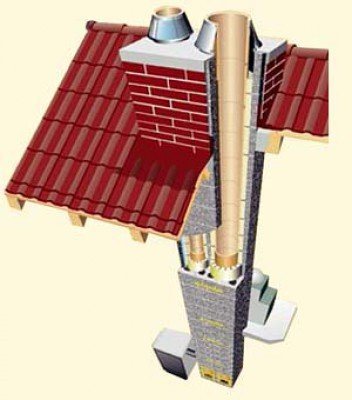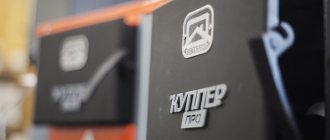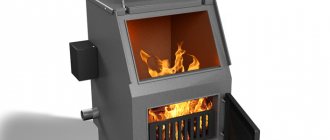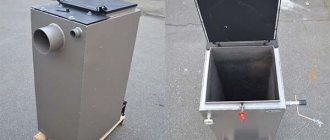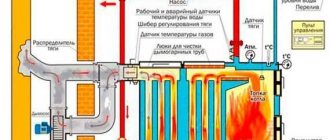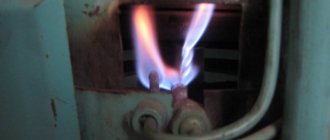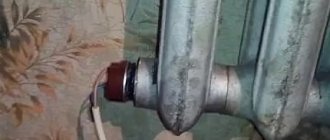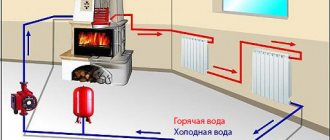Why automatically control the heating temperature
In Russia, owners often begin to realize the need for automatic temperature control after the house is built, the heating system is already installed and working, and gas bills begin to come.
It turns out that outside the house, the air temperature, direction and strength of the wind are constantly changing. Day or night - the temperature of the outside air, even during the day, often changes by a dozen degrees. A changeable wind blows through the house, then no, The changeable sun, then heats up the house, then no. Heat loss at home is constantly changing by different amounts.
In addition, heat is supplied to the house not only from the heating system. Each person in the house serves as a kind of heating radiator with a rather large surface temperature of 36 ° C. Moreover, the number of such additional radiators in each room of the house is constantly changing.
All the energy consumed in the home by electrical appliances and other devices is ultimately converted to heat. Turning on and off each electrical device changes the flow of heat into the room.
The sun through the window, the work of a gas stove or oven - all this creates a constantly changing flow of additional heat into the premises of the house.
Rapid changes in energy flows outside and inside the house lead to constant fluctuations in air temperature in each room. They require the heating system to react equally quickly to these fluctuations.
In order not to bother with all this mess, the owner of the house manually sets on the boiler the temperature of heating the heating water more, so that the temperature in the house is warmer, with a margin. And at the end of the month he looks with surprise at the numbers on the gas bill and scratches his “turnip”. Read the comments to the article - there are many such "owners" there.
The owner learns that it is beneficial to keep a lower temperature in rarely visited areas of the house. Building rules recommend maintaining the air temperature during the heating season in different rooms of the house in the range from +12 to +26 ° C. (See the table from GOST with the temperature parameters in the premises of the house at the end of the article). In the rich countries of the European Union, the room temperature set at night usually does not exceed 16-17 degrees. This is evidenced by the 2014 report presented by the German thermostat manufacturer Tado.
That a change in the room temperature by only 1 ° C leads to an increase or savings in the amount of gas for heating by about 4-5%.
what it is impossible to maintain manually, without automation, a different temperature in each room, but with such high accuracy.
The owner learns that in order to equip the house with automatic temperature control, something needs to be thrown away, replaced and redone in the heating system, and additional equipment must be installed. And for this you will have to buy, drill, chisel, lay, trim, and, most importantly, pay for everything again. That all this automation would be much cheaper if installed immediately, when building a house.
And having connected a room thermostat to the boiler, the owner is surprised to see that the temperature in the house remains constant, while the boiler does not turn on for half a day and does not consume gas... The owner of such savings is in a slight panic and asks a question in the comments - why is this?
Watch this video:
How to significantly improve chimney draft - from cleaning to fan
The most important parameter of the chimney system is draft.Everyone knows that it is very important for the operation of a furnace or boiler, but few people know - what is draft? This parameter determines the speed and volume of flue gas movement through the chimney It is necessary to remove gases and oxygen to maintain the combustion process. The very phenomenon of draft arises from the different densities of cold and hot air. The hot one is less dense and, accordingly, is replaced by the cold one. This is how the hot streams move from bottom to top.
The thrust efficiency can depend on several parameters:

Internal section of the chimney. The smaller its diameter, the faster the rate of release of hot gases. But when they reach a certain minimum size, they will begin to fall into the interior of the room. If the pipe is too large, then the flow of cold air can form the so-called reverse draft.- The amount of soot deposited on the walls of the chimney. It can significantly reduce the effective pipe diameter, resulting in a loss of thrust speed.
- The number of turns in the chimney. Each turn or bend is an additional obstacle to the passage of smoke.
- Tightness of the system. If there are slots in the structure, then cold air can enter the system through them, forming a cold curtain and preventing the passage of smoke.
- Weather. Low atmospheric pressure and high humidity reduce the rate at which hot air is replaced by cold air in the heater.
These factors are major, but not the only ones. Most often, the draft depends on the correct calculation of the chimney design - the optimal section and the number of corner elements.
Failure to comply with the above conditions is often the cause of poor traction. But how can this indicator be determined without special instruments and devices?
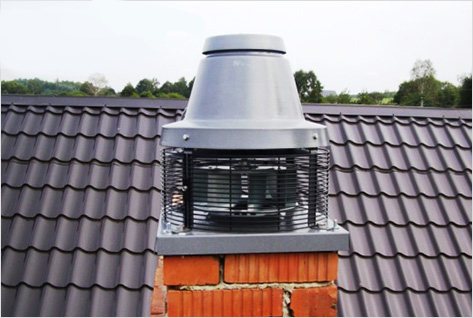

Determining thrust yourself
If the efficiency of the furnace (boiler) has noticeably deteriorated, then there are several ways to check the draft. You can use a special device - an anemometer, but in most cases, purchasing it for home use is economically ineffective. It is best to resort to proven folk methods:
- Candle. If you light a candle, bring it to the chimney and immediately extinguish it, then in the direction of the smoke movement you can see if there is a draft.
- Smoke level in the room.
- A thin piece of paper. The degree of its deviation may indicate the presence of thrust.
Once the problem has been identified, you can begin to resolve it.


Ways to improve traction
There are several ways to improve your cravings, and each one is effective in its own way. But before proceeding with the implementation of one of them, a number of preventive procedures should be done with the very design of the chimney:
- Soot removal (read about it here). To do this, use a special set consisting of a ruff, a sinker and a steel rope.
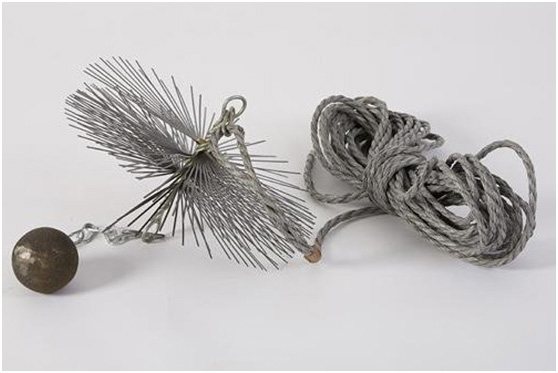

To do this, you need to climb to the roof and lower the ruff into the outlet of the chimney along the entire length of the pipe. Then, with progressive movements, begin to clean the walls of the chimney. At the same time, layers of soot will begin to fall into the furnace, which are then removed.
- Complete sealing of the chimney... Using one of the above methods, it is necessary to check the structure for the absence of cracks or holes. This problem is typical for brick chimneys, when in the process of operation there is a partial destruction of the masonry.
If after these measures the thrust has not improved, then you need to resort to more radical methods.
Draft regulator
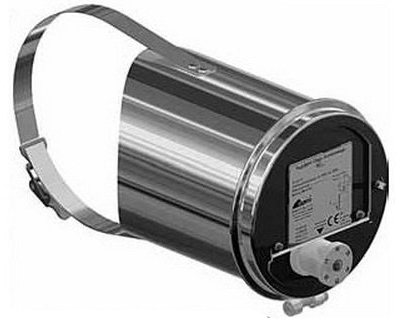

This device is installed on the outlet of the chimney.
After preliminary adjustment, it compensates for the pressure in the pipe with external pressure. In this case, not only the normalization of the heater's operation takes place, but the thrust speed is the same, regardless of external weather conditions.
It should be noted that the regulator helps to increase the efficiency of the entire heating system.
Deflector
This additional structural element is also installed on the outside of the chimney.


Its outer diameter is much larger than the cross section of the chimney itself. This is necessary for the appearance of the effect of pressure drop when the air flow around the obstacle. Those. When the air flow around the deflector design creates a low pressure area within it, which contributes to the creation of conditions for a better thrust speed.
Chimney weather vane
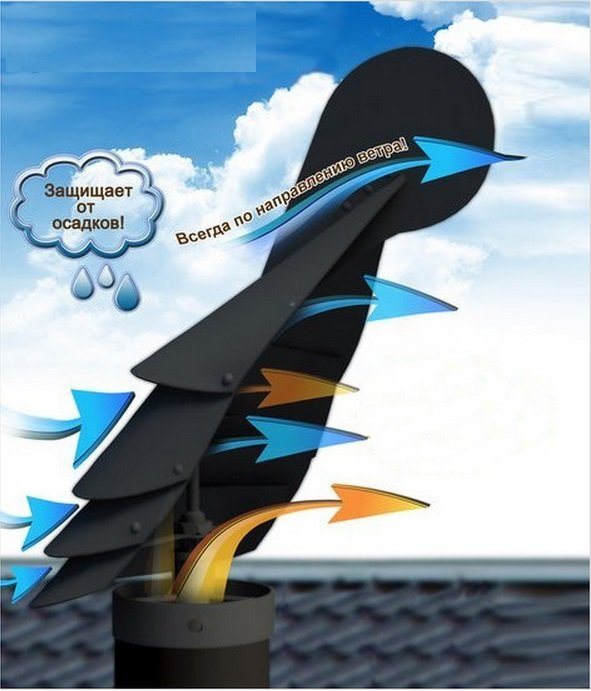

An original design that can not only improve draft, but also protect the chimney from atmospheric precipitation.
Its operation is based on the principle of a deflector and flue gas outlet only from the leeward side. This makes it possible to reduce the external air resistance and thus to normalize the thrust speed.
Smoke fan
One of the most effective methods is to install a special fan on the chimney.
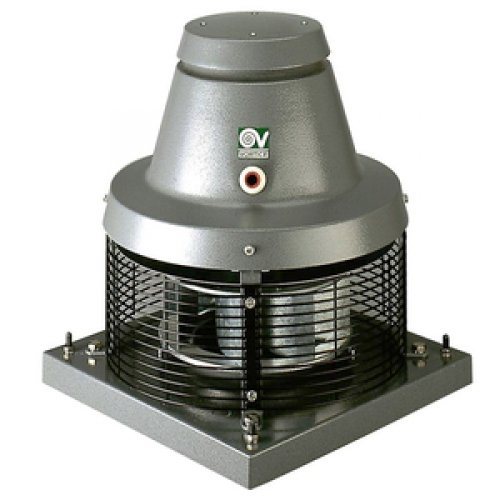

Inside this structure, there is a ventilation system that creates an artificial air flow in the chimney. It creates a discharged air area inside the chimney, thereby improving the conditions for good draft. But to install it, you will need to connect an electric line, which is not entirely convenient, since it will be necessary to comply with all safety rules.
As can be seen from the above, it is possible to improve the draft in the chimney, and this is done efficiently and quickly. But to choose the best method, it is best to use the advice of professionals who will carefully analyze the condition of the chimney.
Room thermostat saves gas
For automatic control of the temperature in the house, boiler manufacturers recommend using room or weather-compensated controller with continuous temperature control principle boiler flow.
Also, you can use two-point principle room thermostat (ON / OFF), but with less efficiency.
Luxury boilers, as a rule, are immediately equipped with a remote control unit. Mounted on the wall of a room, such a unit allows remote control and monitoring of the boiler, and also serves as a room thermostat.
The room regulator allows you to maintain a constant temperature in the heated room with high accuracy. With manual control, the range of temperature fluctuations is larger and deviations are more often in the direction of a higher temperature. Every extra degree in the room leads to an increase in gas consumption for heating. In addition, with the help of the thermostat, you can program an automatic decrease in the temperature in the house in certain periods (at night ...). Refusal of manual control of the heating temperature and installation of an automatic regulator to maintain the required temperature in the room, allow significantly reduce gas consumption for heating.
In addition, the owner does not need to run to the boiler room to change the boiler settings. Custom boiler settings can be changed right in the house, on the thermostat.
A room thermostat or room thermostat temperature sensor is always installed in the largest room in a house or apartment.
Room thermostat saves energy
When the boiler is operating without a room thermostat, the circulation pump runs constantly, consuming electricity. The room thermostat controls not only the gas burner, but also the circulation pump. The circulation pump, controlled by a room thermostat, operates intermittently, which saves energy and pump life.
Weather regulation of temperature reduces gas consumption
All building structures of the house have the property of thermal inertia. For example, when the outside air temperature changes, the outer walls slowly heat up and do not cool down immediately.That is, a change in the outside temperature leads to a change in the indoor temperature with some delay.
When regulating with a room thermostat, the temperature of the heating medium in the system will not change until it starts, for example, to rise in the room due to warming outside. Only after this, the temperature of the coolant will begin to decrease, but, due to the thermal inertia of walls, radiators and other structures, heat generation will continue for some time, and the temperature in the room will be higher than the set one all this time.
For this reason, the accuracy of maintaining the room temperature with a room thermostat will not be very high. The range of temperature fluctuations in the house will be greater than the value that is set by the thermostat hysteresis setting.
If the temperature of the heating medium is changed simultaneously with fluctuations in the outside temperature, then the accuracy of regulation of the air temperature in the room can be increased, which will increase comfort and reduce the gas consumption for heating.
Weather control of the room temperature can be done in one of three ways:
- By connecting only the outdoor temperature sensor to the boiler, without connecting a room thermostat.
- Connecting a temperature sensor and a two-position thermostat to the boiler.
- By connecting a temperature sensor to a room thermostat, if its design provides for such a possibility.
The best temperature stability, which means comfort and energy savings, can be achieved by using the third method of weather regulation.
The first option, with only an outside temperature sensor connected to the boiler, provides a minimum cost - no need to purchase a thermostat.
Connecting an outside temperature sensor and a two-position room thermostat to the boiler is the best option for weather regulation.
A boiler with an outside temperature sensor will react to changes in weather conditions, and the room thermostat will adjust the temperature of the heating medium, depending on the air temperature in the room. The fact is that the temperature in the room depends not only on the heat that comes from the heating system. The temperature in the house changes if, for example, a window is open or the sun is shining through the window, electrical appliances are working, or there are many people in the room. The room thermostat will react to all this, adjusting the temperature in the heating system.
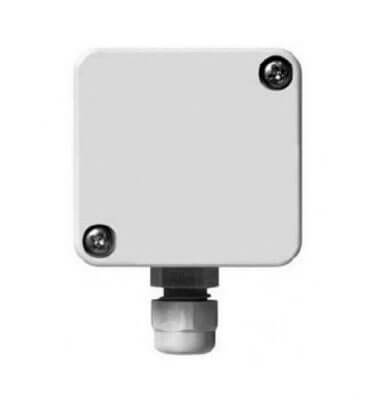

Outside air temperature sensor for gas boiler Protherm
For Protherm boilers, the plant produces an NTC type outdoor temperature sensor with code S010075. The sensor is placed outside, on the facade of the house protected from the sun. The sensor is mounted on a bracket, at some distance from the wall so that the wall temperature does not affect the sensor. The sensor is connected to the boiler with a two-core copper wire with a cross section of at least 0.75 mm2.
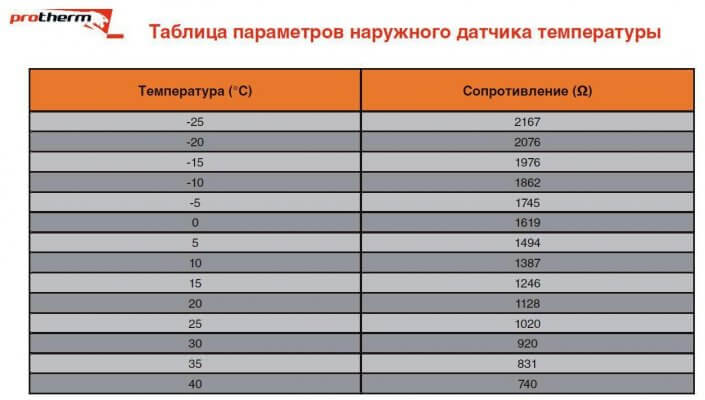

Dependence of resistance on temperature for a thermistor of an outdoor temperature sensor of a gas boiler Proterm. Order number: 0020040797.
There is experience of using as an outside temperature sensor, NTC thermistor B57164-K 222-J, 2.2 kOhm, 5%, from Epcos. You can buy it in the online store. In parallel with the thermistor, you must connect a conventional resistor with a resistance of 2.2 kOhm. This is necessary so that the dependence of the resistance of the outdoor sensor on temperature approximately corresponds to the data indicated in the table.
For weather protection, the thermistor is placed in a suitable box. The cost of such a self-made sensor with a thermistor is much lower than that of a factory sensor.
Traction Test Methods
Since the draft is a key point in the operation of the smoke exhaust system and has a strong effect on the operation of the boiler, it should be checked periodically. This will help to increase or maintain the high performance of the heating device, as well as guarantee the safety of people inside the building.Due to insufficient draft, the chimney may completely fail to cope with the function of removing combustion products, which will lead to carbon monoxide poisoning.
If you do not know how to check the draft in the chimney of a gas boiler, please note that this can be done in several ways:
- Use a special device called an anemometer.
- If you do not want to spend money on the device, resort to the old-fashioned methods. Take a piece of thin paper (even toilet paper will work) and attach it to the chimney. With good traction, the leaf will deflect.
- Poor traction is usually caused by blockages. You can check if they are in the chimney with a metal ball tied to a rope. It needs to be carefully lowered into the chimney and make sure it passes easily.
After checking the draft, you can take measures to improve it to reduce heating costs.
Thermostatic valve on the radiator reduces gas consumption
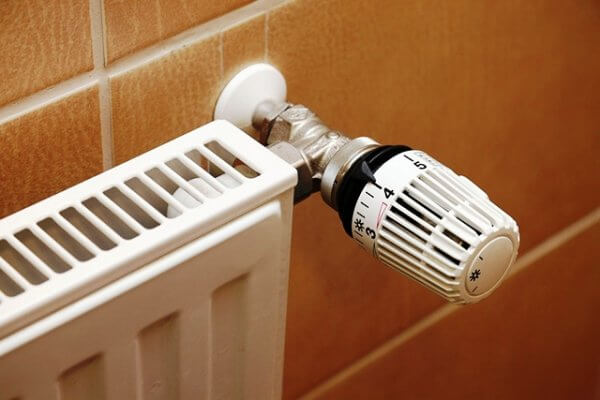

Thermostatic valve - a thermostat for a radiator reduces gas consumption for heating. Installing a thermostat on a radiator is a mandatory requirement of building codes.
Weather regulation changes the temperature of the heating water in the heating system depending on the outside temperature.
The room thermostat regulates, adjusts the temperature of the heating water depending on the temperature in one room, where it is installed.
A room thermostat is always installed in the largest room of a house or apartment. The temperature in other rooms will differ from that which is required in one direction or another. For example, in order to save gas, it is beneficial to keep the temperature in rarely visited rooms lower.
The temperature in other rooms can be regulated using thermostats installed at the heating water inlet to the radiator. A thermostatic valve or an electronic radiator thermostat is used as radiator thermostats.
Thermostatic valve regulates the flow of heating water through the radiator so that the room temperature remains constant, set on the scale of the thermostatic head. The control head of the thermostatic valve contains a bellows filled with liquid or gas. When the temperature in the room changes, the temperature of the liquid (gas) changes. As a result of thermal expansion of the liquid (gas), the bellows changes its position and acts on the valve stem of the valve on the radiator pipe.
On sale you can find thermostatic valves with remote temperature sensor... Such devices provide a more stable temperature in the room, since the influence of a nearby radiator and window is excluded.
Electronic radiator thermostat
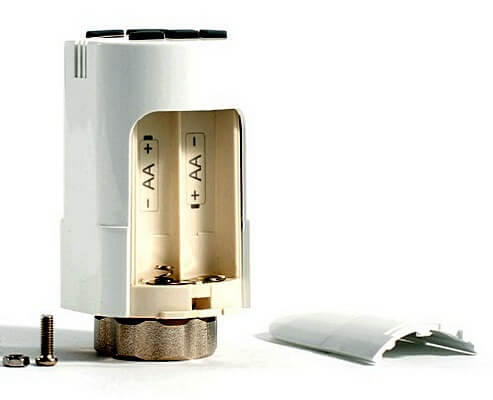

Electronic programmable thermostat for heating radiator. Powered by AA batteries, 2 pcs. Adjustment temperature from 5 ° C to 35 ° C. Hysteresis ± 0.5 ° C. LCD display.
The electronic radiator thermostat, like the head of the thermostatic valve, is mounted on a control valve on the pipe to the radiator. Compared to a thermostatic valve, it has many more control functions.
The radiator thermostat consists of a built-in or remote temperature sensor and a servo-actuator that opens and closes the valve on the radiator.
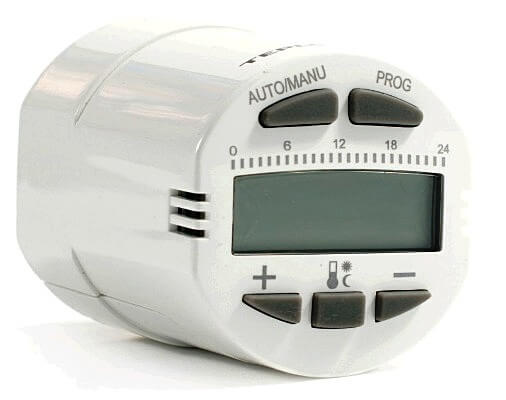

In the programmable radiator thermostat, you can select the temperature mode for daytime and nighttime, for different days of the week. This allows for greater comfort and gas saving... For owners of a country house, a programmable thermostat will maintain an economical heat mode on weekdays, and will switch to warming up mode before arrival.
An electronic programmable radiator thermostat can provide:
- Indoor temperature indication.
- Battery discharge indication.
- System malfunction indication.
- Operating mode indication.
- Installation of an economical and comfortable temperature regime.
- Setting a schedule for alternating between comfort and economy mode for each day of the week.
- Childproof lock function.
- Room ventilation function.
- Function of protecting the valve from acidification.
- System frost protection function.
Automatic temperature control in a house with underfloor heating
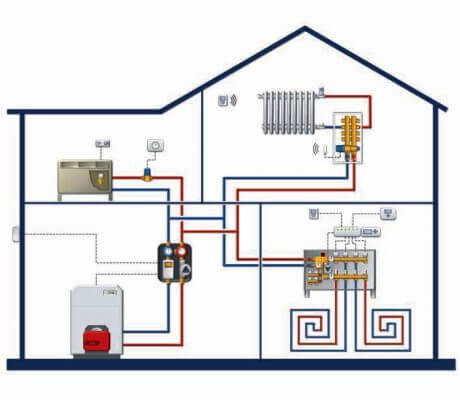

In a house with underfloor heating it is necessary to have three automatic control systems temperature: 1 - underfloor heating according to the air temperature in the room, but with the limitation of the floor temperature; 2 - radiators according to the air temperature in the room; 3 - boiler weather control according to the outside air temperature.
As is known, underfloor heating can be either "comfortable" or "heating".
"Comfortable" warm floor
slightly warms up the surface and provides a pleasant sensation when a person is on the floor. The main heat supply to the room is provided by radiators. For a comfortable warm floor, it is necessary to maintain a constant temperature of the coolant.
"Heating" warm floor,
in addition to comfort, it provides complete heating of the room.
In the conditions of the Russian climate, the relatively low heat output of the warm floor makes it suitable most often only for comfortable heating.
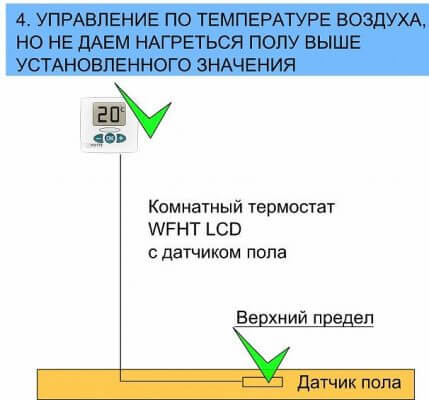

An air temperature sensor in the thermostat housing and a sensor in the floor provide room temperature control and protect the floor from overheating
In a home with a comfortable underfloor heating for temperature control it is necessary to have three automatic control systems.
One system that regulates the work of the warm floor, should be controlled by the room temperature until the floor surface temperature reaches a comfortable level. That is, in the off-season, the house will be heated with warm floor heating.
If the floor temperature reaches the upper limit, and the air temperature in the rooms decreases, then the automatic radiator control system... Radiators will warm up the air in the room, add their own heat to the heat that will constantly come from the warm floor.
The mode of heating the coolant by the boiler must be regulated by one more automatic weather control system that reacts to the outside temperature.
Considering that the underfloor heating system has a high inertia (heats up slowly and cools slowly), it is recommended to use weather automation to control its operation. Then the temperature of the heating medium supplied to the system will be adapted to the outside temperature. Due to this, together with a change in the outside temperature, the temperature of the heating medium circulating in the floor changes.
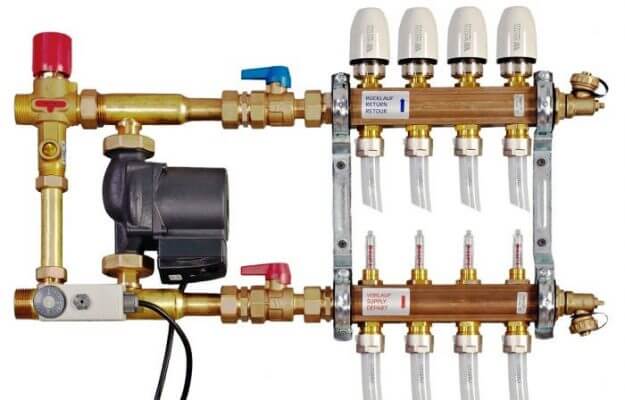

Mixing unit with a circulation pump - on the left. On the right, a collector of underfloor heating pipes is connected to the mixing unit. The manifold is equipped with servo-driven control valves. The valve is controlled by a thermostat through a servo-actuator, which regulates the supply of heat carrier to the underfloor heating circuit, depending on the temperature of the floor surface and the temperature of the air in the room.
Each room with a "warm floor" is at least one circuit (one pipe loop). All these circuits must somehow be combined into one and connected to a boiler or other heat source. Both ends of the pipe of each underfloor heating circuit are connected to a manifold.
To control the temperature of the underfloor heating, it is necessary to select and install a manifold equipped with servo drives on the control valves.
A servo drive is a device that, when an electric current is supplied to it from a thermostat, acts on a valve, opens or closes it. The servo works like a switch, opening or closing the valve completely. The temperature of the underfloor heating surface will be maintained with an accuracy of +/- 0.5 - 1 ° C.
Automation for solid fuel boilers: how to make a heating system with a TT boiler efficient?
In this article we will talk about how to make an efficient heating system based on a solid fuel boiler.
Boiler. It is no secret that solid fuel boilers vary greatly in terms of efficiency. But you should not be guided by the price, brand and country of origin to choose an efficient boiler. Efficiency is determined by such factors as the design of the heat exchanger and the boiler as a whole, the method of fuel combustion (classical or pyrolysis), the size of the loading chamber, the duration of combustion on one tab, etc. It is these factors that determine the efficiency of the boiler, the temperature of the exhaust flue gases and their quality structure.
Fuel. The quality and type of fuel also significantly affects the operation of a solid fuel boiler. Good dry firewood (lumpy logs) has much more heat and much less smoke and soot than damp branches, and the duration of burning will differ significantly. As for good coal, it cannot be compared even with the highest quality and dry wood. On coal, any boiler, regardless of design, produces more power and works much longer than on wood.
Optimal operating mode. The most efficient operation of a solid fuel boiler is at loads close to maximum: in this mode, the fuel is burned completely without residue, the composition of the flue gases meets the highest requirements of environmental standards, and the boiler heat exchanger produces the highest possible efficiency for it.
But such a boiler operation mode is possible only during the "acceleration" of the heating system, that is, when you have melted a cold boiler and it is still cool in the house: the boiler flares up, there is an intensive process of heating the heating system and the room. Further, having achieved the desired temperature in the room, you set the boiler to a moderate combustion mode (maintenance mode) so as not to overheat the boiler, the heating system and the house, and so as not to waste fuel. From that moment on, any solid fuel boiler, both good and not very good, reduces its efficiency: less air for combustion enters the furnace, the fuel burns more slowly, the boiler temperature decreases and is kept at the same level for some time. At the same time, the qualitative composition of flue gases changes: in addition to the main components of smoke - CO₂ and H₂O, a large amount of soot appears (you will notice it by the color of the smoke) and CO (carbon monoxide), as well as other harmful impurities. Soot and carbon monoxide are nothing more than unburned fuel that we throw into the sky.
For boilers with automatic fuel supply, for example, pellet, diesel or gas boilers, it is very easy to achieve the optimal operating mode, or rather the optimal heating performance. To do this, you just need to reduce the amount of supplied fuel. The amount of air supplied to the furnace will also be reduced, but the proportional fuel-air ratio will remain unchanged: less fuel and air - less heat, and vice versa.
But everything is not so simple with a solid fuel - we learned how to regulate the air supply, but the fuel has already been supplied to the furnace, enough time has passed since the ignition, and the entire volume of the firewood bookmark is engulfed in flame, that is, the logs have heated up to a certain temperature, and their entire surface has become actively emit gaseous combustible chemical compounds. By reducing the amount of air, we leave some of the combustible chemical compounds without oxygen, that is, they simply do not burn and, under the influence of high temperature, passing into a gaseous state, evaporate into the atmosphere through the chimney. It is as if we disturbed the gas-air balance in a gas burner, then part of the gas would fly into the atmosphere, while the gas consumption would remain the same, and the amount of heat would decrease.
The obvious conclusion suggests itself: the fuel in the boiler must be burned completely. But then what to do with the excess heat?
We store excess heat for future use. Since ancient times, people have learned to preserve and store heat, and they did it quite simply: in a stone cave or in an earthen hut, only ventilation holes were left so as not to suffocate from a burning fire, and the fire itself was lined with stones around the perimeter - the heated stones remained warm for a long time , after the brushwood burned out in the fire. Later, people began to build massive stone and then brick ovens to heat their homes and prepare food. Often such stoves occupied half of the house, which was not very convenient, but the stove, due to its mass, heated the house for a long time.
How to store heat in modern houses, the size of which has grown significantly, and the number of rooms in them has increased (stove heating is effective only within the room in which the stove is located)?
We will be helped by equipment specially designed for this - a heat accumulator, that is, a well-insulated buffer tank for storing heated water (heat carrier). We will run the boiler at maximum power (that is, in the optimal mode for it), at which it will operate the entire cycle until all the fuel loaded into it has burned out. And the surplus heat will accumulate in the heat accumulator. When all the fuel burns out and the boiler goes out, heat will come to the room from the buffer tank. And only after the heat reserves in the buffer are depleted, it will be necessary to re-heat the boiler.
| Hajdu Heat Storage |
And we will fill the heat accumulator using the Laddomat thermo-mixing valve, which was also specially created for this purpose. It will redistribute the flows between the boiler, the buffer and the heating system, controlling the temperature of the coolant using the thermo-cartridge built into it.
| Laddomat 21-60 |
At the beginning of the boiler firing up, Laddomat will "drive" the heating medium in a small circle, returning the heated water back to the boiler, thus helping it to reach maximum performance in a short time. By the way, the addition of heated water to the boiler return line carried out by Laddomat prevents an undesirable temperature drop in the boiler, protecting it from corrosion.
After the boiler reaches the operating mode, Laddomat will start supplying heat to the heating system (radiators, warm floors, etc.), and “surplus” heat will be stored in the heat accumulator.


Boiler - heat storage system - Laddomat
In addition, Laddomat protects the boiler against overheating. Imagine a power cut in your home, not uncommon in our Palestinians. It's good if you have a diesel generator. And if not? In automatic boilers, fuel simply stops being supplied to the boiler, and it turns off. But what about a wood or coal boiler, you can't completely drown it out? For this case, Laddomat has a self-circulation system, thanks to which it will continue to remove heat from the boiler even in the absence of electricity until the boiler cools down or until electricity appears.


ATMOS boiler with heat storage and Laddomat
In conclusion, it is worth noting that by adding to this "duet" automation (for example, Thermomatic EC Home), which will regulate the flow of heat into the heating system of the house, we will achieve an optimal indoor climate with the lowest possible fuel consumption.
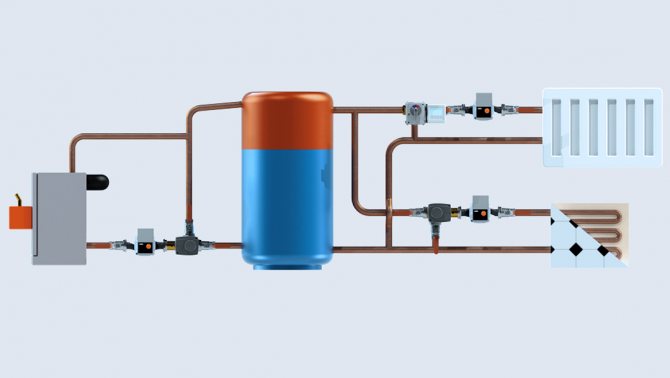

Heating automation Thermomatic EC Home
Underfloor heating thermostats
A thermostat is a device that measures the temperature of something, compares this temperature with a predetermined temperature and, depending on the result of the comparison, commands the servo to turn on or off the control valve. Thus, by turning on or off the heat supply, the thermostat maintains the temperature of something with minimal deviations from the set value, usually with an accuracy of + \ - 0.5 ° C.
To measure temperature, the thermostat can have a temperature sensor built into the body of the device.The temperature sensor can also be remote. The remote sensor is connected to the thermostat with wires.
The thermostat always has buttons or wheels, with the help of which the temperature is set, the stability of which it must ensure. All thermostats have an indication of the current state - "heating on" or "heating off".
The thermostat, depending on the method of connection with the executive servo drive, can be wired or wireless.
The smallest budget option is a wired thermostat. The device itself is installed in a room in which it must maintain the temperature. The underfloor heating collector with servo drives can be installed in another place, for example, in a boiler room. These devices are connected to each other by thin wires.
The wireless thermostat transmits the control command to the collector servo drive via radio. For this, there is a radio transmitter in the thermostat housing, and a radio receiving unit is installed near the collector. Installing a wireless thermostat can be beneficial when automation work is carried out in an already built house - there is no need to lay wires and disturb the decoration of the premises.


Thermostat with the function of regulating the room temperature and the temperature of the warm floor. It works with two thermal sensors, one in the device case, the other remote, in a warm floor.
To regulate the air temperature and the temperature of the warm floor in accordance with the algorithm - we adjust the air temperature in the room, but do not let the floor heat up above the set temperature, a thermostat with the appropriate functions is needed.
Floor heating thermostat:
- Must work with two temperature sensors: a built-in air temperature sensor and a remote floor temperature sensor.
- The thermostat must be able to set separately the air temperature and the temperature of the warm floor.
- An algorithm for regulating the air temperature with the limitation of the temperature of the underfloor heating surface must be laid down.
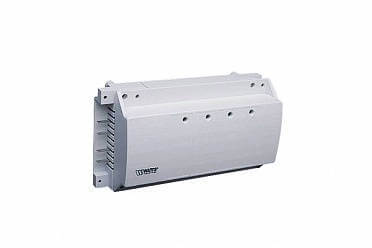

Switching module for connecting several underfloor heating circuits to one thermostat
One thermostat can control several servo actuators installed on one manifold. The thermostat with servo drives is connected through a special block - switching module.
Selecting a room thermostat - thermostat
Let us consider the choice of automation devices for controlling the heating system in a private house using the example of an equipment manufacturer of the Protherm trademark.
A room thermostat installed in the room measures the current air temperature and, if the temperature deviates from the value set in the settings, sends a control signal to the boiler.
The room thermostat, which controls the operation of the boiler, isinstalled in the largest room of the house... Radiators in the room where the thermostat is installed should not have valves that regulate the flow rate of the coolant. In other rooms, a thermostatic valve must be installed on each radiator, which regulates the flow rate of the coolant through the radiator, depending on the temperature in this room.
In heating systems with underfloor heating and radiators, the automatic air temperature control system is more complex.
Read: "Automatic control of air temperature in a house with underfloor heating and radiators".
The signal from the thermostat to the boiler can go through wires, or maybe wirelessly. In the latter version, a unit for receiving a radio signal from a wireless thermostat is installed on the boiler.
It is recommended to use thermostats of the same brand to control Protherm boilers. The manufacturer of boilers under the Protherm trademark produces several modifications of room thermostats for their gas boilers.
Types of heat loss
Allocate the nominal and real efficiency. The real is always less than the nominal. This is also due to the fact that there are different types of heat loss.There are such types of heat loss:
- Physical underburn. The indicator depends on how much excess air, which does not take part in the formation of thermal energy, is present in the equipment during fuel combustion. Its value is also influenced by the temperature of the exhaust gases. In winter, during severe frosts, when the boiler is operating at full capacity, the physical underburning can reach 20%.

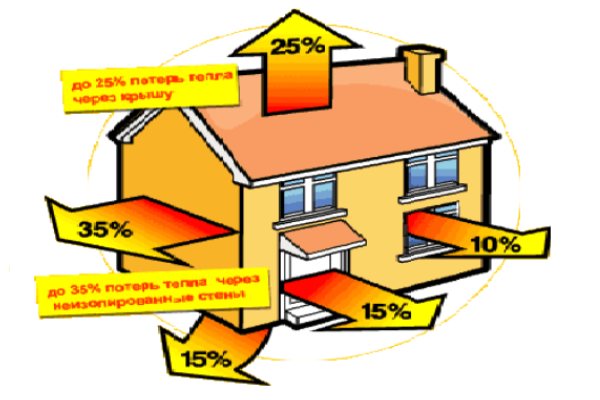
Heat loss from gas heating and low efficiency - Chemical underburning. The value of this criterion increases depending on the amount of carbon monoxide oxide. Carbon does not burn in heating equipment, it escapes through the chimney, however, it has the ability to generate a large amount of thermal energy. Carbon monoxide is produced by the combustion of carbon. Heat loss from chemical underburning ranges from 5-7%.
- Mechanical underburning is typical for solid fuel heating boilers. This is a loss of efficiency as a result of incomplete combustion of fuel and ash formation. The percentage is insignificant - only 1-3.
In addition, heat loss can occur through the walls of heating devices. In this case, the heat is dissipated directly into the environment through the outer casing of the heater.
Two-position thermostats - thermostats for gas boiler
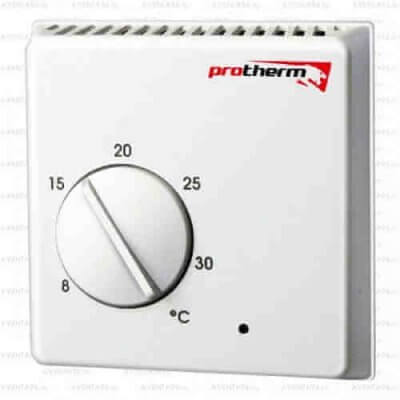

Electromechanical two-position room thermostat Protherm Exabasic for a gas boiler is simple, cheap, but temperature fluctuations in the heated room will be significant - about 2-3 ° C.
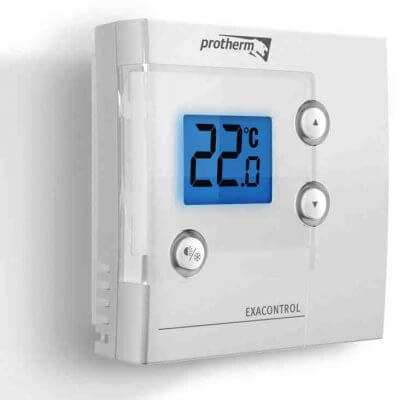

Electronic two-position room thermostat Protherm Exacontrol provides higher accuracy and stability of maintaining the temperature in the room, has a function of protecting the heating system from freezing. The display shows the current room temperature.
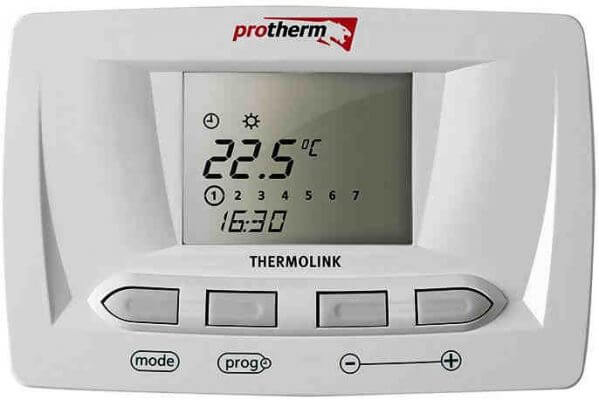

Electronic two-position programmable room thermostat - thermostat Protherm Thermolink S
Thermolink S is an electronic two-position programmable regulator, which differs from previous models in that it allows you to set the temperature according to one weekly program with the possibility of combinations of three different time intervals (morning, afternoon, evening).


Weekly program for regulating the heating temperature in a house, apartment with a room thermostat Protherm Thermolink S
In addition, it is possible to set one of three temperature modes: "Comfort", "Eco" (economy) or "Vacation" mode.
Thermolink S regulator supports the function of frost protection of the heating system when the room temperature drops to 3 ° C.
The display shows the current room temperature as well as the time and day of the week.
Features of the boiler with a two-position thermostat
Two-position thermostats have a relay with contacts at the output. Contacts can be in one of two positions: closed or open. Closed thermostat contacts connected to the boiler switch on the boiler heating mode. When the contacts are opened, the heating mode is switched off. The boiler works in cycles - on / off. There are no changes in the heating mode settings on the boiler itself.
The cyclic operation of the boiler under the control of a two-position room thermostat can hide the boiler timing, which occurs due to a significant discrepancy between the capacities of the boiler and heating devices (read the beginning of the article about timing).
Many even argue that the boiler clock can be eliminated not by adjusting the gas valve, but by installing a room thermostat.
However, if the power of the boiler significantly exceeds the power of the heating devices, then the frequency of the boiler operation cycles with a two-position thermostat increases. The boiler switches on and off more often. In addition, the range of temperature fluctuations in the room expands.
Correct setting of the power of the gas boiler is necessary and when the boiler is operating under the control of a room thermostat.
The sensitivity of the electronic two-position room thermostat is 0.5 ° C. The thermostat switches contacts when the room temperature changes by half a degree.


The two-position room thermostat uses self-learning algorithm TPI - regulation... Fuzzy logic pulse width control. adapts to ambient conditions and ensures precise temperature control and minimum gas consumption. More details. ... ...
Reducing power through the menu
The task of adjusting the power of the equipment is to exclude excessive cyclicity of the boiler operation in the absence of adaptation of the equipment settings to the heating system. It is allowed to limit the maximum power indicators through the service menu if there is computer automation in the design.
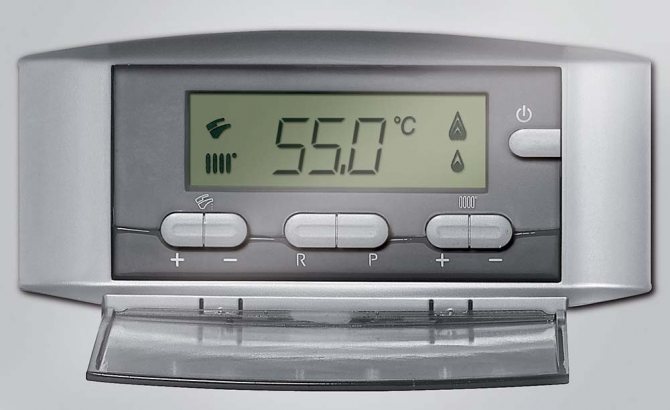

In manual mode, it is required to enter the service menu using a special code (not for all models), after which the required values of the power indicators of the gas boiler are easily set. The transition to the service is carried out through the control panel. A similar adjustment option is also suitable for effectively eliminating the impulse operation of heating equipment (clock).
All modern gas boilers with a modulating burner allow you to reduce the power through the menu. To do this, simply study the passport of your boiler and you will understand how to do it.
Boiler temperature controllers
Protherm Thermolink P programmable thermostat


Room programmable thermostat Protherm Thermolink P with interface (eBus) for gas boiler Protherm Gepard (Panther)
The Protherm Thermolink P programmable thermostat allows you to set the temperature according to one weekly program with the possibility of combinations of 3 different time intervals (morning, afternoon, evening).
It is possible to set one of three heating temperature modes: "Comfort", "Eco" or "Vacation" mode. It is possible to set the hot water temperature.
The Thermolink P thermostat supports the frost protection of the heating system when the room temperature drops to 3 ° C.
The display shows the current room temperature, time and day of the week.
Interface regulator Thermolink RC is a modification of Thermolink P with similar properties and parameters, however with wireless connection to the boiler.
The difference between the interface Thermolink P and the two-position Thermolink S
The Thermolink P room temperature controller is connected to the boiler via the eBus communication bus. This bus is used to exchange data between the microprocessors of the thermostat and the boiler. The thermostat has the ability to change the boiler settings.
Thermolink two-position thermostat S maintains the required temperature in the room due to the fact that at a certain moment it turns on and off the boiler.
Thermostat Protherm Thermolink P with interface (eBus) provides room temperature control by changing the boiler settings - the boiler burner power and the heating medium temperature change. The boiler runs continuously, not in cycles.
In addition, the owner does not need to run to the boiler room to change the boiler settings. Custom boiler settings can be changed directly on the thermostat. For example, adjust the hot water temperature. The boiler autodiagnostics codes are also shown on the thermostat display.
The interface controller can work in conjunction with an external air temperature sensor connected to it.
Setting the weather regulation on the boiler
In order for the temperature in the house to remain constant, the temperature of the heating water in the system, when the outside temperature changes, must change according to a certain law. This pattern is determined by the magnitude and nature of the building's heat loss, as well as the parameters of the heating system.
The dependence of the heating water temperature on the outside temperature is shown on the graph by the heating curve.The slope of the heating curve is very individual for each building.
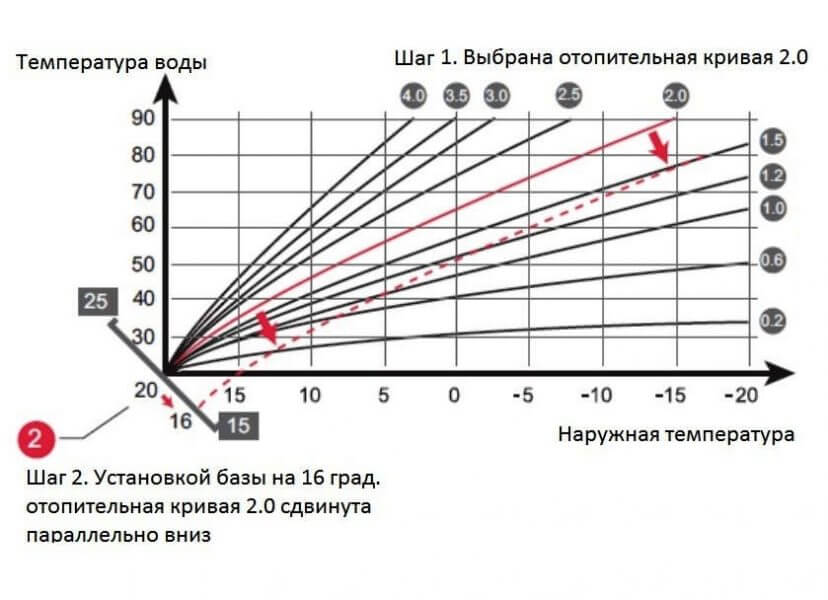

Heating curves for some parameter values in line d.43 of the service menu of the Protherm Gepard (Panther) boiler ..
To work with an outside temperature sensor connected to the boiler, the heating curve for the house is selected in two steps.
Step 1. In line d.43 of the service menu, select the parameter that sets the slope of the heating curve (in the graph above). Parameter factory setting = 1.2. Select the parameter that corresponds to the heating curve passing through the known intersection point on the heating water temperature and outside temperature graph. These temperatures (this point) are determined by calculation. Often no calculations are made and this point is not known in advance.
Usually, the parameter of the slope of the heating curve in line d.43 is selected empirically. Leave the factory setting of the parameter in line d.43 and observe in which direction the room temperature changes when the outside temperature fluctuates. If, when the outside temperature drops, the room temperature rises, then it is necessary to reduce the slope of the heating curve, i.e. decrease the value of the parameter in line d.43, and vice versa. The task is to choose such a parameter value at which a change in the outside temperature will not lead to temperature fluctuations in the house. At this step, the main thing is to achieve a stable temperature in the room, regardless of the absolute value of this temperature.
Step 2. In line d.45 of the service menu, select the base temperature of the heating curve in the range of 15 - 25 ° C. Parameter factory setting = 20. The parameter in line d.45 sets the absolute value of the room temperature. If, after selecting the slope of the heating curve in step 1, the room temperature is stable, but low, then the temperature parameter in line d.45 is increased, and vice versa. In this case, the heating curve on the graph rises or falls, but its slope does not change.
If line d.47 is called in the service menu, the display screen will show the temperature, which is measured by the outside temperature sensor.
Read: How to enter the service menu of the boiler Protherm Gepard (Panther)
Connecting the thermostat and outside temperature sensor to the gas boiler
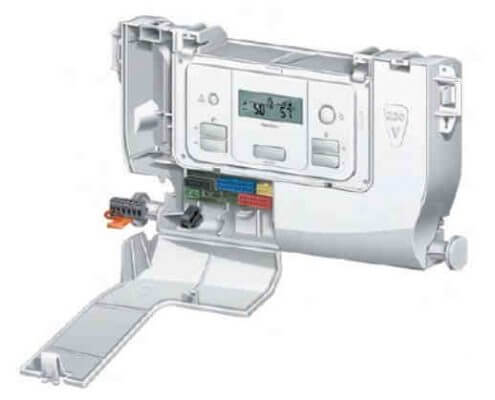

The wires from the room thermostat - thermostat are connected to the terminal block marked as X17 (in the black picture on the left) in the 24 V compartment of the control panel of the Protherm Gepard (Panther) gas boiler.
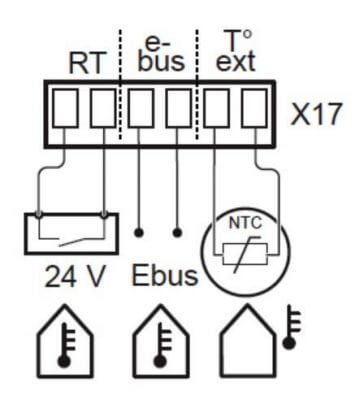

The wires from the two-position thermostat are connected on the block to the RT terminals, instead of a jumper.
The wires from the Thermolink P interface thermostat are connected to the same block, but to the terminals marked "e-Bus". Leave the jumper between the RT terminals in place.
An outdoor temperature sensor can be connected to the Toext terminals.
Connecting a two-position wireless thermostat to the boiler - video
The wireless room thermostat consists of two units.
The executive unit is installed near the boiler and connected to the boiler with wires, to the same terminals as a conventional wired thermostat. To supply power to the executive unit, it is also connected to a 220 volt electrical network.
The measuring (control) unit with the display is mounted on the wall of the heated room. The signal from the measuring unit goes to the executive unit via a radio channel.
Air temperature standards in the living quarters of the house
In a private house, when setting up the heating system, it is recommended to be guided by the air temperature standards in the premises, established by "GOST 30494-2011. Interstate standard. Residential and public buildings. Indoor microclimate parameters ":
| The name of a room | Temperature (оС), optimal / permissible |
| Living room | 20-22 / 18-24 |
| The same, but in areas with the outside temperature of the coldest five-day period -31 ° C and below | 21-23 / 20-24 |
| Kitchen, toilet | 19-21 / 18-26 |
| Bathroom, combined bathroom | 24-26 / 18-26 |
| Staircase, lobby | 16-18 / 14-22 |
| Pantry | 16-18 / 12-22 |
In addition to temperature, another important parameter of the indoor microclimate is the relative humidity. The standard also regulates the relative humidity of air during the heating period for living rooms is optimal in the amount of 45-30%. The permissible air humidity in all rooms of the house should not exceed 60%.
Measurement of air temperature and humidity should be carried out in the center of the room at a height of 1.7 m, in cloudy weather and the outside air temperature is below -5 ° C.
Optimal microclimate parameters - a combination of values of microclimate indicators, which, with prolonged and systematic exposure to a person, provide a normal thermal state of the body with a minimum stress of thermoregulation mechanisms and a feeling of comfort for at least 80% of people in the room.
Permissible microclimate parameters - a combination of values of microclimate indicators, which, with prolonged and systematic exposure to a person, can cause a general and local feeling of discomfort, a deterioration in well-being and a decrease in working capacity with increased tension of thermoregulation mechanisms and do not cause damage or deterioration in health.
In residential buildings, in accordance with SP 60.13330.2010 "SNiP 41-01-2003 Heating, ventilation and air conditioning" during the cold period of the year, when there are no people in them, it is allowed to reduce the microclimate indicators, taking the air temperature below the standard, but not lower than: 15 ° С - in residential premises; 12 ° С - in public, administrative and household premises. The normalized temperature in the premises must be ensured before the start of use.
In the basement of the house, the air temperature should not be lower than +5 ° C.
Tips for the developer
How to reduce the high gas consumption by the boiler for heating the house:
- Choose the power of one gas boiler, the minimum required to compensate for heat losses at home. When installing two boilers, their total total power must be equal to the minimum required.
- In order to save gas and comfort, it is advantageous to use a heating and hot water supply system with a single-circuit boiler and a boiler. With a heating system power of less than 15 kW. it is better to refuse the use of a double-circuit boiler, a system with a boiler will be most profitable.
- Choose a gas boiler with an open combustion chamber, atmosphere.
- When choosing a boiler brand, among other characteristics, be sure to evaluate the boiler efficiency specified in the technical documentation.
- Clean the soot from the boiler heat exchanger annually.
- Check the function and immediately eliminate any defects in the air supply and flue gas discharge of the boiler.
- Be sure to connect a room thermostat and an outdoor temperature sensor to the boiler. Installing a simple two-position thermostat and outdoor temperature sensor will pay off in one to two years.
- Install a thermostatic valve for each radiator in all rooms (except for the room with a room thermostat). This will allow avoiding overheating in many rooms and keeping the temperature lower.
- Rooms with underfloor heating should be equipped with automatic room temperature controllers with protection against floor overheating.
Only in this way, bit by bit, by fulfilling these conditions, it is possible to reduce to a minimum the gas consumption associated with the operation of the heating system.
How can you improve your cravings?
On the Internet, you can find many tips on how to improve the draft in the boiler chimney. If the pipes become clogged, you must first clean them well. If there are blockages or a fallen brick is stuck in the passage, the problem should be solved immediately, since this situation can be dangerous for people in the room.
To improve draft, people usually raise the chimney height. Due to the pressure difference at the top and bottom points, the thrust is improved. Also, various devices and devices are used - from deflectors to deflectors to rotary turbines.Their main feature is that they force the air in the system to move forcibly, as a result of which the combustion products are effectively removed and the flow of oxygen to the boiler is ensured. The disadvantage of these devices is that there are many low-quality products on the market that quickly fail.
If you want to improve traction for a long time, then you should pay attention to the innovative FuranFlex Black material. After polymerization, the flexible stocking turns into a strong tube that is resistant to acids and other aggressive substances. It can be used both in the construction of new systems and for the repair or modernization of old chimneys. Good traction in FuranFlex polymer pipes is achieved due to the fact that the material has low thermal conductivity, the surface of the pipes inside is smooth and has no joints. You can learn more about the benefits of the solution from our specialists.
Similar articles:
You have questions? We can call you absolutely free!
We will contact you and answer any questions you may have!
